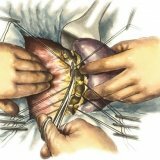Operations on the pancreas

Blood enters the pancreas along the anterior and posterior pancreatoduodenal arteries and along the lower pancreatoduodenal artery. Venous outflow passes through the splenic, left gastric, upper and lower mesenteric and left gastric veins.
Operations on the gland are performed in connection with organ damage, malformations, inflammatory or parasitic diseases, with cysts and tumors. Surgical interventions are performed under the influence of general anesthesia and muscle relaxants.
Laparotomy interventions are also possible. In this case, the incisions and the approach to the gland depend on the nature and localization of lesions.
Emergency operations on the pancreas can occur if there is a peritonitis or signs of internal bleeding. In other cases, the planned operation is applied.
Pancreatic surgery is performed as follows.
After opening the pancreas( through the gastric collar ligament) and releasing the cavity of the stuffing bag from the blood mixed with unbound tissues or with a pancreatic secretion, the surface ruptures of the gland are sewn together with the organ capsule, blood vessels and bruises are opened and bandaged.
In case of ruptures of the pancreatic flow or complete rupture of the pancreas, individual seams are superimposed on it, and at the same time the pancreatic duct is sewn. If more serious damage to the body of the organ and pancreatic duct occurred, pancreatic junostomy is performed - an anastomosis with the jejunum region turned off by Brown or Ru. When the pancreas ruptures, its proximal end is completely closed, and the distal end is connected to the area of the jejunum that is turned off.
With significant violations of the tail of the pancreas, left side resection of the organ( the so-called distal pancreatectomy) is performed together with the spleen.
If the head of the gland and duodenum is destroyed, pancreatoduodenal resection is performed, that is, removal of part of the pancreas with part of the duodenum.
Operations on the damaged pancreas are completed by draining the gland bag.
Removing stones.
In the presence of stones in the main pancreatic ducts of the pancreas, pancreaticolithotomy is prescribed. After dissecting the parenchyma of the gland and the duct wall over the calculus, it is extracted outward. The dissected fabrics are sewn by separate seams, external drainage of the duct is made by T-shaped drainage.
In the event of multiple concrements and stricture of the duct, which are determined by intraoperative pancreaticography, a longitudinal dissection of the pancreas in the tail area, body area and in the main duct part is performed. The concussions are removed, the constrictions and strictures of the duct are dissected, followed by pancreatic uninostomy. If the location of the stones occurs at the mouth of the pancreatic duct, they are removed after cutting the duct in the area of the large papilla of the duodenum operatively or endoscopically.
Operations to remove cysts.
Operations on the pancreas, localized cysts are performed by the method of removing the cyst with part of the gland. Such an intervention is called a cystectomy. Often used resection of the body together with a cyst. A much more gentle and simple operation is also used, which involves draining the cyst cavity with the stomach( cystogastrostomy).Drainage of the cyst with the duodenum is called cystoenterostomy. With the help of various drains, rubber or chlorovinyl, which are injected into the lumen of the cyst, external drainage is carried out. Also, an open cyst can be hemmed in the wound of the anterior abdominal wall. But this operation often leads to the formation of prolonged fistulas, malignancy and relapse cysts, therefore it is not desirable to use.
The pancreas also carries out such surgical interventions as the treatment of external fistulas. Operative treatment consists in excision of fistulas on all their extent. It is also possible to resect the pancreas cyst along with the fistulous course.
In some cases, the fistula of the pancreas connects with the organs of the gastrointestinal tract( for example, with the stomach).Then the distal end of the fistula is sewn into the lumen of the stomach together with the skin.
Operations for tumors.
The most complex operations on the gland are surgical interventions when removing tumors. So, with pancreatic cancer, the only radical interventions are gastro-pancreatoduodenal resection. During this operation, the gastric outlet, the head of the pancreas and the duodenum are removed. Then gastroentero - and pancreatic jugular anastomoses are formed.
The bleeding bile duct is often used for the operation of cholecystectomy with interintestinal anastomosis according to Brown. This is an operative intervention with long-term( more than 2 months) jaundice.
With cancer of the body and tail of the pancreas, resection of the gland with splenectomy is applied. All pancreas, spleen and duodenum are removed if there is cancer of the head and tail of the pancreas. This operation is called splenpancreatodudenectomy.



